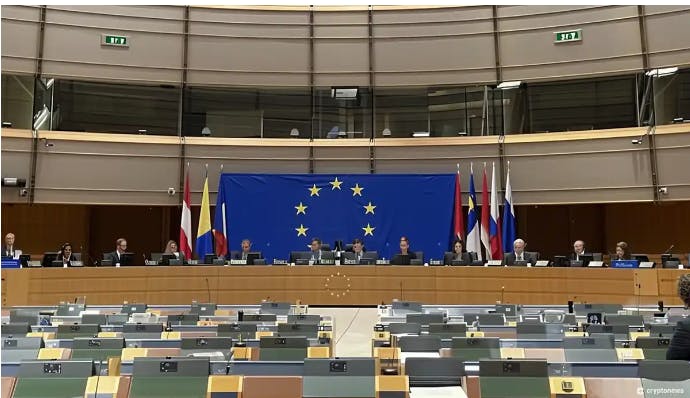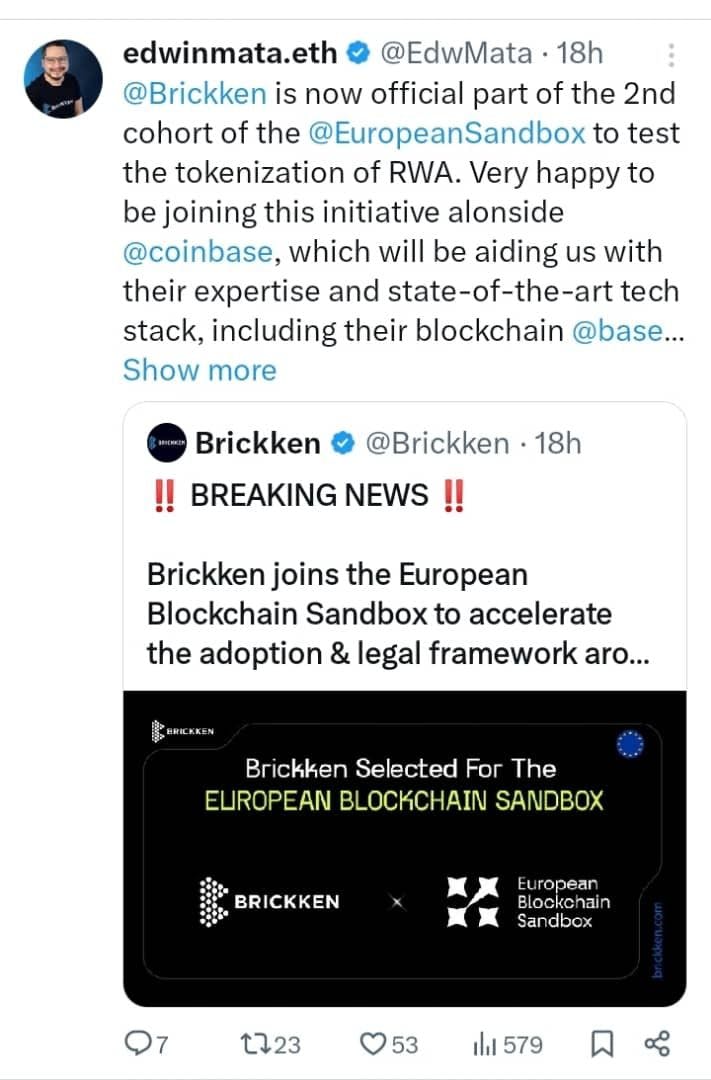
The European Union (EU) took the early lead in providing a global benchmark for crypto regulation with the approval of the Markets In Crypto-Assets (MiCA) legislation in June 2023. Meanwhile, opinions are still divided over the suitability of MiCA with the Travel Rule dominating the conversation.
Although there is broad agreement on the need for proactive crypto regulation, the challenge lies in finding the right balance between fostering innovation and ensuring adequate regulatory oversight. By establishing the European Blockchain Regulatory Sandbox, the EU aims to bridge the gap between regulating blockchain technology and mitigating the risks associated with it.
The European Blockchain Regulatory Sandbox, an
In this article, we explore the European blockchain Regulatory Sandbox, the classification of RWA under MiCA, and with reference to the EU selection of Brickken, a leading EU-based real world asset(RWA) tokenization company, as a participant in the regulatory sandbox, which began in 2023.
The European Blockchain Regulatory Sandbox Explained
Crypto regulatory sandboxes are still very much the platforms for regulators to engage democratically with the crypto industry by allowing crypto-native businesses to test their products, services and models in a transparent and controlled environment.
The European blockchain regulatory sandbox was launched by the European Commission in 2023 as a robust and controlled platform to test and develop blockchain-based solutions for the EU crypto markets, thereby allowing participants from various blockchain sectors to experiment with real-world scenarios while engaging in an open dialogue with the EU regulators.
With the Markets In Crypto-Assets (MiCA) regulation, the comprehensive framework for crypto-assets within the EU, becoming fully operational by December 2024, the regulatory sandbox serves to enable EU-based digital assets companies to not only test their products and services but to also measure their level of compliance with the extant legislation as.
Brickken, a Barcelona-based RWA tokenization platform, was recently selected to explore this collaborative approach to test its RWA products and solutions. The keypoint about the EU regulatory sandbox is that it is ultimately designed to foster innovation while mitigating potential risks associated with blockchain technology in line with the framework established by MiCA.
The Sandbox Implications For MiCA
The EU is indubitably a leader in crypto regulation, outpacing the US in the provision of regulatory clarity for the crypto industry. The European blockchain regulatory sandbox reinforces the EU’s leading position as it aims to provide legal certainty, enhance consumer protection, and foster a more stable and secure crypto market.
As a launchpad for responsible and compliant blockchain solutions within the EU, its has several implications for MiCA including:
Enhancing Crypto Compliance: Companies or participants are offered a platform to test their solutions and channel their toward ensuring a full compliance with the rules outlined in MiCA, such as token issuance, consumer protection, data protection, etc.
Enhancing The Implementation of MiCA: The regulatory sandbox can shape the implementation of MiCA, enabling regulators to strike a balance between fostering innovation and mitigating risks and highlighting the need for a sustained collaboration between regulators and crypto businesses.
Tokenizing Real-World Assets in a MiCA-Compliant Manner
The recent selection of Brickken as a participant in the EU regulatory sandbox brings us to examine MiCA’s provisions on the tokenization of real-world assets (RWAs), focusing on its mission to ensure a responsible and compliant tokenization of real world assets in the EU.
MiCA’s established rules on crypto assets reflect the EU’s intention to regulate an industry with a diverse service offerings ranging from real estate to intellectual property to artwork. (RWAs consisting of traditionally illiquid assets hold a lot of potential and its Total Addressable Market (TAM) is worth billions of dollars).
RWAs are classified as a class of crypto tokens on the blockchain, representing a fractionalized ownership of real estate, artwork and traditionally illiquid assets. Depending on their characteristics, these tokens may be categorized as one of the three types of crypto assets recognised by MiCA: Asset-Referenced Tokens (“ART”), Electronic Money Tokens (“EMT”), and Other Tokens(ie utility token).
Participating in the EU regulatory sandbox will enable EU-based RWA-focused companies such as Brickken to gain more insights into the MiCA’s regulatory compliance requirements on token issuance, investor protection and other mandatory rules, highlighting the potential of tokenization technology, especially in a MiCA-regulated environment. Most especially, it can serve as a case study for compliant and innovative RWA companies in the EU.
According to Brickken CEO Edwin Mata Navarro, “this opportunity validates our innovative approach to asset tokenization and also allows us to collaborate with regulators and other industry leaders to build a stronger and more reliable blockchain ecosystem. The experience and knowledge we gain in this regulatory sandbox will be valuable for our future growth and success”.
Conclusion
The EU’s commitment to promoting responsible blockchain innovation is evident in the establishment of the EBSI sandbox, which seeks to foster collaboration between key players in the blockchain industry and the EU regulators, especially with regards to the Markets In Crypto Assets(MiCA)regulation.
As a platform, it highlights the need for a supportive environment for the growth of blockchain innovation, and it serves as a medium to unlock the full potential of blockchain technology across various sectors within the EU running from financial services, supply chain management to defense, and healthcare.
Finally, it presents an opportunity for EU-based RWA-focused companies to work towards becoming MiCA-compliant in their services and operations across the EU. This signifies that as more innovative companies participate in the sandbox and collaborate with regulators, the future of tokenization technology seamlessly integrating into the European economy is guaranteed to create new opportunities for businesses, investors, and the citizens.







